Lessico
Carato
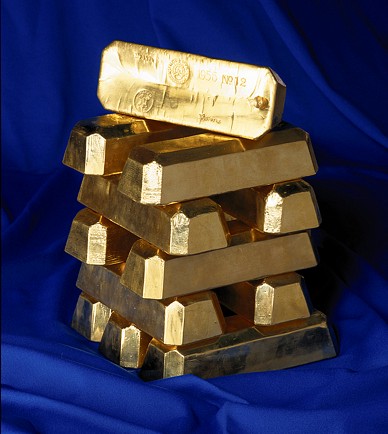
Il carato
è un'unità di misura pari a 0,2 grammi. La parola carato deriva dall'arabo qirat,
ventiquattresima parte d'un denaro, in greco kerátion, carruba, il cui
seme si usava per pesare avendo un peso estremamente uniforme di circa 1/5 di
grammo, e il greco kerátion è diminutivo di kéras, corno. Il
carrubo![]() ,
che produce le carrube, è la Ceratonia siliqua della famiglia
Cesalpiniacee
,
che produce le carrube, è la Ceratonia siliqua della famiglia
Cesalpiniacee![]() ,
per altri delle Fabacee.
,
per altri delle Fabacee.
Che i semi del carrubo abbiano tutti un peso estremamente uguale è una credenza del passato, ormai sfatata. Scienziati dell’Università di Zurigo hanno compiuto una ricerca a tal proposito e constatato che il peso dei semi varia come quello di tutti gli altri semi. Gli scienziati suppongono che il seme del carrubo sia stato preso come peso comparativo per il fatto che è relativamente facile constatarne la differenza dimensionale a occhio nudo. Sono state fatte delle prove con delle persone che hanno stimato le dimensioni di vari semi, confrontandoli con un seme campione, con il risultato che il massimo errore di valutazione rientrava nel 5%. La variazione del peso di semi di carrubo presi alla rinfusa arriva al 25%.
Già dall'antichità fino al medioevo il carato si utilizzò per la pesatura di quantità molto piccole e tuttora rimane l'unità di misura ponderale dei diamanti, delle pietre preziose in genere e delle perle. Il carato, che spesso in passato era usato come unità di peso di metalli preziosi, fu rapportato e definito con precisione solo nel 1832 in sud Africa, il luogo di maggior produzione ed esportazione di diamanti del mondo, dove ne fu stabilita la connessione con il sistema metrico tradizionale (chilogrammi). Pesando con una bilancia a braccia uguali più semi di carruba di un albero sud Africano e poi facendo la media aritmetica dei valori ottenuti, ne derivò un valore pari a 0,2 grammi circa che rimane tutt'ora in uso.
Per quanto riguarda le leghe d'oro il termine carato assume un'accezione differente dall'unità di misura ponderale propria delle gemme e delle perle, mutandosi nello standard proporzionale universalmente accettato che quantifica le parti d'oro in una lega su base 24/24. Dunque, nel caso delle leghe d'oro, un carato equivale a una di parte d'oro su un totale di 24 parti di metallo costituente la lega.
Ne deriva, ad esempio, che la dicitura 18 carati sta a indicare che la lega è costituita da 18 parti d'oro fino e 6 parti di altri metalli e viene abbreviato con le sigle ct o kt o prevalentemente con la sola k spesso affiancata al numero senza alcun spazio intermedio. Ad esempio: 18k.
Conseguentemente a quanto detto l'oro di massima purezza è pari a 24 carati (24 parti d'oro fino su 24 totali) e si definisce con la dicitura: 24k.
The carat is a unit of mass used for measuring gems and pearls. Currently a carat is defined as exactly 200 mg (0.007,055 oz, 3.086 grains). This definition, known as the metric carat, was adopted in 1907 at the Fourth General Conference on Weights and Measures, and soon afterwards in many countries around the world. It is universally used today. The carat is divisible into one hundred points of two milligrams each.
For diamonds, a paragon is a flawless stone of at least 100 carats (20 g). The ANSI X.12 EDI standard abbreviation for the carat is CD.
The word came to English from French, derived from the Greek kerátion, “fruit of the carob”, via Arabic qirat and Italian carato. The Latin word for carat is siliqua. In past centuries, different countries each had their own carat unit, all roughly equivalent to the mass of a carob seed. These units were often used for weighing gold.
Carob seeds were used as weights on precision scales because of their reputation for having a uniform weight. However, a 2006 study found carob seeds to have as much variation in their weights as do other seeds, though it seems that it is easier than with other seeds to recognize particularly large or small specimens and remove them. Thus, the carob seed was used as a weight not because it was naturally more uniform in weight, but because it could be more easily standardized.
Board of Trade carat
In the United Kingdom, before 1888, the Board of Trade carat was exactlygrains; after 1887, the Board of Trade carat was exactlygrains. Despite it being a non-metric unit, a number of metric countries used this unit for its limited range of application.
The Board of Trade carat was divisible into four diamond grains, but measurements were typically made in multiples ofcarat.
Pound carat and ounce carat
There were also two varieties of refiners’ carats once used in the United Kingdom — the pound carat and the ounce carat. The pound troy was divisible into 24 pound carats of 240 grains troy each; the pound carat was divisible into four pound grains of 60 grains troy each; and the pound grain was divisible into four pound quarters of 15 grains troy each. Similarly, the ounce troy was divisible into 24 ounce carats of 20 grains troy each; the ounce carat was divisible into four ounce grains of 5 grains troy each; and the ounce grain was divisible into four ounce quarters of 1¼ grains troy each.
The carat of the Romans and Greeks
The solidus (carat) was also a Roman weight unit. There is literary evidence that the weight of 72 coins of the type called solidus was exactly a Roman pound, and that the weight of a solidus was 24 siliquae. The weight of a Roman pound is generally believed to have been 327.45 g or possibly up to 5 g less. Therefore the metric equivalent of 1 solidus was approximately 189 mg. The Greeks had a similar unit of the same value.
The carat in Byzantine Egypt
A carob based weight unit was also used in Egypt in the Byzantine and early Arab periods. In this region, glass weights were used for weighing coins. From these the weight of the Egypt carat has been reconstructed as 196 mg. This is consistent with the average weights of carob seeds in the region.
The Syrian and Arabic carat in Mohammad's time
According to literary sources, the Arabic carat was only 2% less than the Syrian carat. Based on coins and glass weights their weight was reconstructed as approximately 212 mg. This is consistent with literary information that a solidus weighed slightly less than 22 carats.
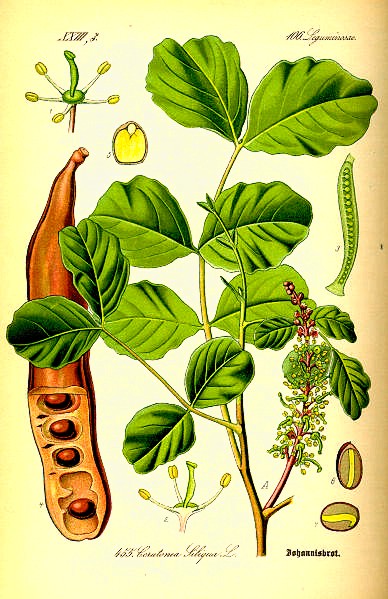
Il Carrubo (Ceratonia siliqua L., 1753) è un albero sempreverde appartenente alla famiglia delle Fabaceae. Insieme all'Olea europaea è una specie caratteristica dell'associazione fitosociologica Oleo-ceratonion. È un albero, raramente contorto, sempreverde a chioma espansa, ramificato in alto. Può raggiungere un'altezza di 10 m. Il fusto è vigoroso, con corteccia grigiastra-marrone, poco fessurata. Ha foglie composte, con 2-3 paia di foglioline coriacee, di colore verde scuro lucente sopra, più chiare sotto, con margini interi e più o meno dentellati agli apici.
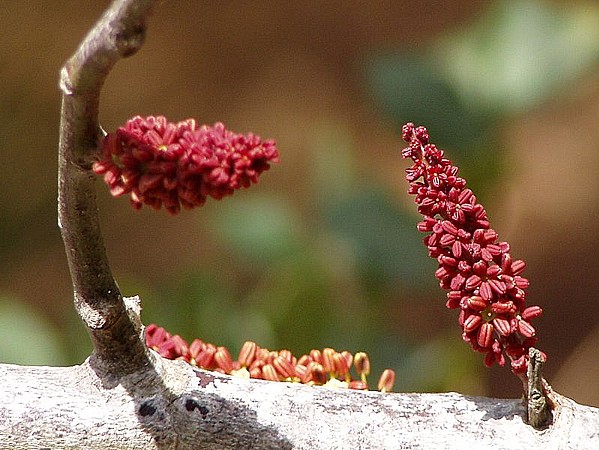
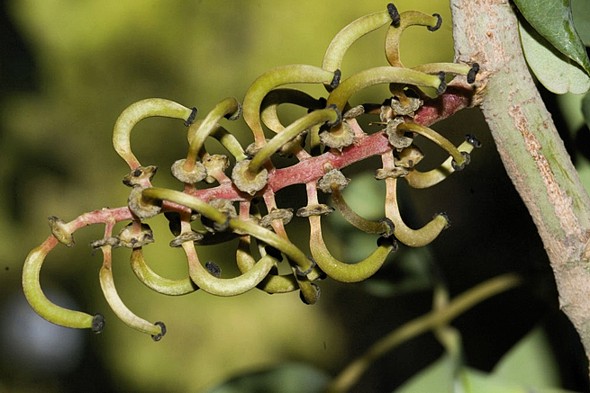
I fiori, a corolla papilionacea e portati su corte spighe, possono comparire, prima della fogliazione, sul tronco e sui rami più vecchi. I frutti, chiamati carrube o vajane, sono delle silique lunghe 10-20 cm, spesse e cuoiose, dapprima di colore verde pallido e poi, a maturazione, marrone scuro. Esse presentano una superficie esterna molto dura, con polpa carnosa, grassa e zuccherina. Contengono semi scuri, ovoidali, assai duri.
Si tratta di una specie tipica del Mediterraneo proveniente dalla penisola arabica. È coltivato, specialmente in Nord Africa, Grecia e Cipro. In Italia, grandi produzioni si trovano ancora a Caltagirone, Comiso, Palma di Montechiaro, Raffadali, Santa Croce Camerina, Vittoria. I grandi carrubeti di Sicilia stanno scomparendo, ma ancora resistono in alcune aree, come nel ragusano e nel siracusano. Apprezzato nelle regioni d'origine per l'ombra delle chiome.
Oggi i frutti (privati dei semi) vengono usati come alimentazione del bestiame. Un tempo furono usati come materiale da fermentazione per la produzione di alcool etilico. Come uso della tradizione popolare i semi macinati in farina venivano usati come anti-diarroici. I frutti si conservano per molto tempo e possono essere consumati comunemente freschi o secchi o, in alternativa, passati leggermente al forno. I semi, immangiabili, sono particolarmente uniformi come dimensione e peso e costituivano l'unità di misura (carato) usata per la valutazione delle gemme.
Tipica è in Puglia nelle piante molto longeve la comparsa, dopo le prime piogge d'agosto, del cosiddetto fungo del carrubo (Laetiporus sulphureus), venduto a peso d'oro nei mercati rionali e cucinato come carne al ragù.
The Carob tree (from Arabic: kharub and Hebrew: charuv), Ceratonia siliqua, is a leguminous evergreen shrub or tree of the family Leguminosae (pulse family) native to the Mediterranean region. It is cultivated for its edible seed pods. Carobs are also known as St. John's bread. According to tradition of some Christians, St. John the Baptist subsisted on them in the wilderness. A similar legend exists of Rabbi Shimon bar Yochai and his son.
This tree grows up to 10 meters tall. The crown is broad and semi-spherical, supported by a thick trunk with brown rough bark and sturdy branches. Leaves are 10–20 cm long, alternate, pinnate, and may or may not have a terminal leaflet.
Most carob trees are dioecious. The trees blossom in autumn (September-October). The flowers are small and numerous, spirally arranged along the inflorescence axis in catkin-like racemes borne on spurs from old wood and even on the trunk (cauliflory); they are pollinated by both wind and insects. Male flowers produce a characteristic odour, resembling semen. The fruit is a pod which can be elongated, compressed, straight or curved, and thickened at the sutures. The pods take a full year to develop and ripen - up to the next flowring season, the following autumn. The ripe pods eventually fall to the ground and are eaten by various mammals, thereby dispersing the seed.
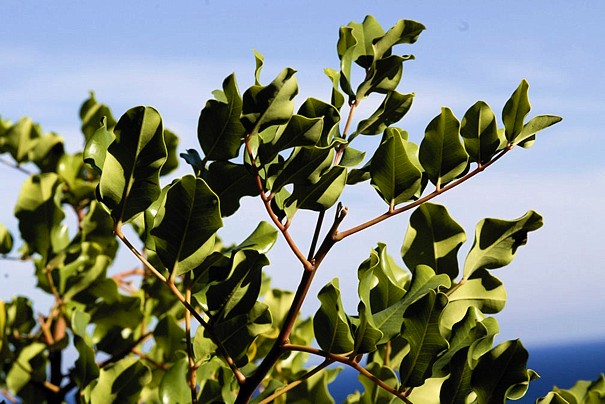
Carob is a member of the legume family, and as such its roots host Rhizobia bacteria which lives in symbiosis with the tree and convert atmospheric nitrogen into nitrates which can be used by plants to make proteins.
It grows well in warm temperate and subtropical areas and tolerates hot and humid coastal areas. It is a xerophytic (drought-resistant) species, well adapted to the ecological conditions of the Mediterranean region, present in the altiplanic desert of South America. The deep root systems of these trees are intolerant of waterlogging. The carob tree is typical in the southern Portuguese region of the Algarve, where it has the name alfarrobeira (for the tree), and alfarroba (for the fruit), as well as in southern Spain (Spanish: algarrobo, algarroba), Malta (Maltese: Harruba), on the Italian islands of Sicily and Sardinia (Italian: carrubo, carruba) and in South Greece as well as many Greek islands such as Crete and Samos. The common Greek name is Charoupia. The various trees known as algarrobo in Latin America (Hymenaea courbaril in Colombia and four kinds of Prosopis in Argentina and Paraguay) belong to a different family, the Cesalpinaceae. It also grows in the island of Crete in Greece.
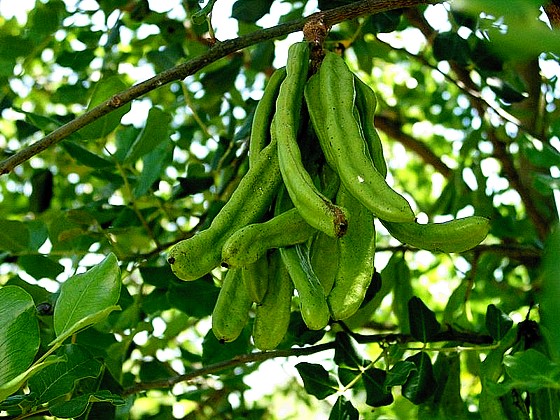
Ceratonia siliqua, the scientific name of the carob tree, derives from the Greek kerátion , “fruit of the carob” (from kéras "horn"), and Latin siliqua "pod, carob." The term "carat", the unit by which diamond weight is measured, is also derived from the Greek word kerátion, alluding to an ancient practice of people in the Middle East weighing gold and gemstones against the seeds of the carob tree. The system was eventually standardized and one carat was fixed at 0.2 grams.
In late Roman and early Byzantine times the pure gold coin known as the solidus weighed 24 carat seeds (about 4.5 grams). As a result, the carat also became a measure of purity for gold. Thus 24 carat gold means 100% pure, 12 carat gold means the alloy contains 50% gold, etc. Subsistence on carob pods is mentioned in the Talmud and the New Testament.
Carob was eaten in Ancient Egypt. It was also a common sweetener and was used in the hieroglyph for "sweet" (nedjem). Dried carob fruit is traditionally eaten on the Jewish holiday of Tu Bishvat. Carob juice drinks are traditionally drunk during the Islamic month of Ramadan.
Carob pods were the most important source of sugar before sugarcane and sugar beets became widely available. Nowadays, the seeds are processed for the use in cosmetics, curing tobacco, and making paper.
Carob powder and carob chips are used today as an ingredient in cakes and cookies. Carob is sometimes used as a substitute for chocolate. However, there is a significant difference in flavour. Carob is better suited to accompany fruit cooking (e.g. Apple and Carob cake) as it is milder and isn't as bitter as chocolate. The seeds, also known as locust beans, are used as animal feed. They are also the source of locust bean gum, a thickening agent. In Egypt, carobs are consumed as a snack. Crushed pods are used to make a refreshing drink. Compotes and liqueurs are made from carob in Portugal, Spain and Sicily. Carob has proven effective in relieving diarrhoea in infants.